| |||
| Podlaskie | |||
| Capital | Białystok | ||
|---|---|---|---|
| Residents | 1.193.348 (2014) | ||
| surface | 20,180 km² | ||
| no tourist info on Wikidata: | |||
| location | |||
 | |||

The Podlaskie Voivodeship(Polish: Województwo podlaskie) lies in the northeast Poland with the capital Białystok. Apart from the capital, there are no other large cities. The voivodeship borders on the voivodeships Warmia-Masuria and Mazovia in the west as well Lublin in the south. She has international borders Russia, Lithuania and Belarus. The name can be translated as Land under the forest translate. As the name suggests, Podlachia is shaped by the forest. It is one of the most sparsely populated and wooded voivodeships in Poland. At the same time, Podlachia applies together with Warmia-Masuria as the poor house of Poland, with the Masovian Voivodeship immediately to the west being the richest. Podlaskie, on the other hand, is considered to be the region with the lowest prices in the EU.
Four of the 23 Polish national parks are located in the Podlaskie Voivodeship, placing Podlaskie after the Lesser Poland Voivodeship, which has six, takes second place in Poland. It is considered the "wild east" of Poland with the last primeval forest in Central Europe. This is where the last European bison live in the wild. Moose, wolves and brown bears can also be found. Numerous evidence of Jewish culture and the wealth of the Polish magnates. The Branicki Castle in Białystok is considered the Polish Versailles. The renaissance synagogue in Tykocin is considered the most beautiful in Europe. Polish Muslims also live here - the Tatars together with Orthodox and Catholic Poles. In Supraśl is probably the most beautiful Orthodox church in Poland. The kayak route along the Czarna Hańcza is one of the most attractive in Poland. In the lake area Wigry There are excellent opportunities for water sports in the far north-east of Poland. The lake belonging to it Hańcza At over 100 m, it is the deepest in Poland and the entire northern European lowlands from France to Estonia.
Regions
The name Podlachia is derived from the forest that occurs here in numerous still preserved primeval forests. The historical Podlaskie region, however, only occupies part of the voivodeship and lies outside of it in Mazovia and Lublin as well as Belarus, so it is not congruent with it. The Podlaskie Voivodeship covers only about half of the area of the historical Podlaskie Region.
The north-western part of historical Podlaskie makes up the south-eastern part of the voivodeship. Parts of the historical region also belong to the north Suwalszczyzna, parts of Mazovia in the west and parts of Traken to the Podlaskie Voivodeship in the east. After the Lublin Union of 1569, the Suwalszczyzna and Traken were part of the Lithuanian part of the Polish-Lithuanian aristocratic republic. To a small extent, the voivodeship also has a share in the historical regions of Polesie and Black Rus, most of which are now located in Belarus and Ukraine.
Geographically, the region can be divided into four parts. In the north are the lake and moraine landscapes of the Suwałki Lake District and the Lycker Lake Districtto a large extent with the primeval forests of the Rominter Heath, Johannesburg Heath and Augustów Heath are overgrown. To the south of it are the swamps of the Biebrza to that up to Knyszyn Heath pass. This in turn is followed by the wet meadows to the south and west Narew and its tributaries, as well as in the east of the Białowieża Primeval Forest. The south and southwest is from the valley of the Bug embossed.
- The Suwalszczyzna around Suwałki occupies over a third of the voivodeship's area and is the most sparsely populated part of the region. The Lithuanian minority in Poland is also at home here.
- The historical one Mazovia takes up about a fifth of the area of the voivodeship and is particularly characterized by the Narew and the Bug.
- Traken in the east is on the border with Belarus. The Tatars, the oldest Muslim minority in Poland, settled here in the 17th century.
- The center and south take the historical one Podlaskie one that makes up almost half of the voivodeship's area.
places
With less than 60 inhabitants per km², Podlaskie is the most sparsely populated voivodeship in Poland. The national average is 123 inhabitants per square kilometer. Only the voivodeship capital is a major city with 300,000 inhabitants. Other places are:
Suwalszczyzna
Mazovia
- 6 Rajgród
- 7 Grajewo

- 8 Szczuczyn

- 9 Goniądz

- 10 Stawiski

- 11 Kolno

- 12 Nowogród

- 13 Jedwabne

- 14 Łomża

- 15 Zambrów

- 16 Wysokie Mazowieckie

- 17 Czyżew

Traken
- 18 Suchowola

- 19 Dąbrowa Białostocka

- 20 Sokółka

- 21 Bohoniki
- 22 Krynki
- 23 Kruszyniany
Podlaskie
- 24 Mońki

- 25 Tykocin

- 26 Knyszyn

- 27 Choroszcz

- 28 Czarna Białostocka

- 29 Wasilków

- 30 Supraśl

- 31 Białystok

- 32 Łapy
- 33 Suraż

- 34 Zabłudów

- 35 Michałowo

- 36 Ciechanowiec

- 37 Brańsk

- 38 Bielsk Podlaski

- 39 Hajnówka

- 40 Kleszczele

- 41 Grabarka
- 42 Siemiatycze

- 43 Drohiczyn

Other goals
The most valuable treasure of Podlasie is nature. About 30% of the voivodeship area is subject to nature conservation. The voivodeship is called "The Green Lungs of Europe" and "The Green Lungs of Poland" because of its natural wealth. The voivodeship has a share in five large primeval forests:
- 1 Rominter Heath in the far north
- 2 Johannisburger Heide in the far west
- 3 Augustów Heath south of the Suwałki Lake District
- 4 Knyszyn Heath downtown
- 5 Białowieża Primeval Forest
 in the southeast
in the southeast
National parks
There are four national parks in Podlaskie:
- The 6 Wigry National Park
 lies around the lake of the same name, which at 73 m is one of the deepest in Poland. The area is home to around 190 species of birds and 25 species of fish live in the waters. On a headland there is a baroque monastery of the Kamadulese, which with its twelve hermitages is now used as a hotel.
lies around the lake of the same name, which at 73 m is one of the deepest in Poland. The area is home to around 190 species of birds and 25 species of fish live in the waters. On a headland there is a baroque monastery of the Kamadulese, which with its twelve hermitages is now used as a hotel. - The 7 Biebrza National Park
 is considered to be the largest and most valuable moorland in Central Europe. The Biebrza River was preserved in its natural course over a length of 135 km. Large areas of land are regularly flooded during spring floods. More than 270 different bird species have their habitat and breeding grounds in the protected area. The national park attracts ornithologists from all over the world, especially in spring. There are around 480 km of hiking trails and 400 km of cycle paths within the national park for tourists. You can kayak a 135 km long stretch of the Biebrza River through the park. The national park administration maintains an information center near Osowiec-Twierda. Kayaks are also rented there.
is considered to be the largest and most valuable moorland in Central Europe. The Biebrza River was preserved in its natural course over a length of 135 km. Large areas of land are regularly flooded during spring floods. More than 270 different bird species have their habitat and breeding grounds in the protected area. The national park attracts ornithologists from all over the world, especially in spring. There are around 480 km of hiking trails and 400 km of cycle paths within the national park for tourists. You can kayak a 135 km long stretch of the Biebrza River through the park. The national park administration maintains an information center near Osowiec-Twierda. Kayaks are also rented there. - The 8 Narew National Park
 is known as the Polish Amazon, as the Narew River with its countless tributaries is known. The area has been protected as a national park since 1996. This area is home to around 200 species of birds, most of which also breed there. The seat of the national park administration is in Kurowo in an old manor house. Exhibitions take place there and you can walk on a nature trail from here.
is known as the Polish Amazon, as the Narew River with its countless tributaries is known. The area has been protected as a national park since 1996. This area is home to around 200 species of birds, most of which also breed there. The seat of the national park administration is in Kurowo in an old manor house. Exhibitions take place there and you can walk on a nature trail from here. - The 9 Białowieża National Park
 is the most famous national park of Podlaskie, which is recognized by UNESCO as World natural heritage was registered. King Władysław Jagiełło hunted here as early as 1409. In the centuries that followed, the forests were a preferred hunting ground for the rulers. This contributed to the fact that the jungle has been preserved to this day. The forest covers a total area of 1250 square kilometers and extends to Belarus. Nature is left to its own devices here. Only part of the jungle may be visited with guides on designated trails. A total of around 5000 different plants and 15000 animal species can be found here. The oldest trees are around 500 years old. The big inhabitants of the jungle are the bison. About 250 of them live there in the wild. The primeval forest village is the starting point for tours in the Białowieża National Park Białowieża. There is a good tourist infrastructure there with several new middle-class hotels. The information center of the national park administration with a newly established museum is located in the castle park.
is the most famous national park of Podlaskie, which is recognized by UNESCO as World natural heritage was registered. King Władysław Jagiełło hunted here as early as 1409. In the centuries that followed, the forests were a preferred hunting ground for the rulers. This contributed to the fact that the jungle has been preserved to this day. The forest covers a total area of 1250 square kilometers and extends to Belarus. Nature is left to its own devices here. Only part of the jungle may be visited with guides on designated trails. A total of around 5000 different plants and 15000 animal species can be found here. The oldest trees are around 500 years old. The big inhabitants of the jungle are the bison. About 250 of them live there in the wild. The primeval forest village is the starting point for tours in the Białowieża National Park Białowieża. There is a good tourist infrastructure there with several new middle-class hotels. The information center of the national park administration with a newly established museum is located in the castle park.
In addition to the national parks, there are protected areas:
- three landscape parks (Suwalski, Łomżyński, Narew valleys),
- the park the Knyszyn Heath,
- 88 nature reserves,
- and 15 other protected natural areas.
Kayak and houseboat trails
- Augustów Canal
- Biała
- Biebrza
- Blizna
- Brok
- Bug
- Czarna Hańcza
- Kamianka
- Leśna Prawa
- Marycha
- Narew
- Narewka
- Nice
- Nurzec
- Orlanka
- Płoska
- Rominte
- Rospuda
- Scale
- Sokołda
- Supraśl
- Swislatsch
- Wołkuszanka
- Ślina
Lakes
- 1 Blizno
- 2 Gaładuś
- 3 Hańcza
- 4 Necko
- 5 Pomorze
- 6 Rospuda Filipowska
- 7 Raygrodsee
- 8 Sajno
- 9 Serwy
- 10 Siemianówka Reservoir
- 11 Studzieniczne
- 12 White Augustów Lake
- 13 Wigry
background
The large forest area between Poland and Lithuania only came into focus when the two states united in the Union of Krewno in the 14th century under the Jagiellonians. The Polish-Lithuanian kings, now between Krakow and Vilnius commuted, had castles and towns built on their way through the heathland and discovered the forests for hunting. Even after the Jagiellonian extinction in 1572, Podlaskie was still on the inner border of the Polish-Lithuanian aristocratic republic. During this time, the Polish-Lithuanian magnates discovered the area and had magnificent castles and palaces built here in the Baroque, Rococo and Classicism styles with baroque or Romanesque parks.
In terms of cultural wealth, Podlaskie is the most multiethnic voivodeship in Poland, and for centuries it has been inhabited by Poles, Belarusians, Jews, Lithuanians, Ukrainians, Russians, Sinti and Roma, Tatars, Germans and believers of the Church of the Ancient Rite. Many cultural monuments of these people have remained here.
After the three partitions of Poland in the 18th century, Podlaskie came to Russia and returned to Poland after the First World War, where it was then in the north-central part of Poland and was a popular destination for the Warsaw elites of the interwar period. In 1921 Białowieża one of the first national parks in Europe was founded in which the bison, which is already extinct elsewhere, was and is being protected.
In the town Suchowola is the geographical center of Europe calculated in 1775. This is where the straight lines that divide the European continent into length and width intersect and the most distant points of Europe connect here.
language
Polish is the official and colloquial language. Polish is spoken with an eastern dialect. For many Poles outside the region, the local dialects sound like singing. In Podlaskie the foreign language skills of the population are good. Almost all of the younger residents speak very good or good English. And finally, Polish is not as difficult to learn as you might think at first. The minority languages include Belarusian and Lithuanian.
getting there
_Lichen99.jpg/220px-WK15_Białystok_(4)_Lichen99.jpg)

We recommend arriving by plane, car, bus or train.
By plane
The voivodeship does not have an international airport. You can travel by plane from Germany, Austria and Switzerland 1 Warsaw Airport![]() (IATA: WAW), the 2 Modlin Airport
(IATA: WAW), the 2 Modlin Airport![]() (IATA: WMI) at Warsaw or the 3 Olsztyn Airport
(IATA: WMI) at Warsaw or the 3 Olsztyn Airport![]() (IATA: SZY) at Olsztyn approach.
(IATA: SZY) at Olsztyn approach.
road
The road conditions are not particularly good. The road connections Warsaw-Białystok and Warsaw-Suwałki are, however, very good and have been / are being upgraded to form an expressway.
By train
The rail network is not particularly tight, but the Warsaw-Białystok train service is impressive. All other destinations should be approached from Białystok.
By boat
On the Augustów Canal can be reached by houseboat.
mobility
The center of Podlaskie is Białystok. From there, all important places can be easily reached by car, train or bus. The fares are very low. Petrol is cheapest in Poland in Podlaskie.
Tourist Attractions





- Tykocin - a pretty little baroque town located west of Białystok. There is a baroque synagogue from 1642. It was destroyed by the Nazis and was rebuilt after the war. Today it houses a Jewish museum. The baroque parish church has also been beautifully restored. The Renaissance Synagogue and Renaissance Jewish Cemetery in Tykocin are worth seeing. Not far from Tykocin are the stork village Pentowo and the rustic inn and hotel in Kiermusy "Dworek nad Łąkami".
- Supraśl is a small town northeast of Białystok. There is a beautifully restored Greek Orthodox monastery of the Basilian people from the 16th century. The church had been destroyed by the National Socialists and was only rebuilt in recent years. The rescued icons are shown in a small museum. The Uniate Monastery of Supraśl is considered the most beautiful of its kind in Poland.
- Białystok experienced its boom in the early 19th century with the development of the textile industry. Badly damaged in the Second World War, the city now has around 300,000 inhabitants and is the administrative seat of the Podlaskie Voivodeship. Ludwik Zamenhof was once born in Bialystok. It was no accident that he invented the world language Esperanto. Because a colorful mixture of peoples has lived together in Białystok for a long time. There were Poles, Jews, Belarusians, and Lithuanians, Roma and Tatars, there were Catholics, Orthodox, Old Believers and Muslims. The Jews did not survive the Nazi era. Their large synagogue in Białystok was burned with around 1,000 people in 1941. The most important architectural monument is the baroque Branicki Palace in the city center, which is also known as the "Polish Versailles" because of the rococo-style gardens. The building is used by the Medical University. The town hall on the old market square, built in the middle of the 18th century, Today it houses the Museum of Regional Culture, which exhibits weaving art and valuable frescoes from the 16th century.Białystok has several theaters and a philharmonic orchestra, and on the outskirts of town there is a large aviation center offering balloon flights and sightseeing flights. The Russian Orthodox Church of St. Nicholas the Wonderworker and the neo-Gothic Church of St. Mary are also worth seeing.
- In Choroszcz the Branickis had their summer residence, a beautiful baroque palace with a baroque garden.
- Suwałki was recognized by the Council of Europe in 1993 for his efforts to protect the natural environment. In the center of the city, around Plac Piłsudskiego, there are some beautiful late classicist buildings.
- Łomża is on the edge of the Puszcza Kurpiowska. In the once heavily destroyed city, some important structures have been rebuilt. The landmark is the cathedral built at the beginning of the 16th century. Archaeological and folklore collections are exhibited in the District Museum at 1 Krzywe Koło Street. In the nearby Nowogród there is an open-air museum with old farmhouses as well as windmills and workshops from the region. There is a well-known brewery in Łomża (Browar Łomża) active.
- Augustów is surrounded by three lakes. The city with 30,000 inhabitants is a well-known sailing center. Excursions by the White Fleet also take place from here. The Puszcza Augustowska is one of the largest contiguous forest areas in Poland. A popular, almost 100 kilometers long paddling route leads through the jungle over the Augustów Canal and further over the river Czarna Hańcza.
- Bielsk Podlaski with its baroque monasteries was once an important trading center in the region.
- Zambrów was an important city in Kurpengau (Kurpie).
- Hajnówka is the gateway to Białowieża National Park.
- Grajewo lies on the southern edge of the Lycker Lake District.
- The Tatar villages are located east of Białystok, near the border with Belarus. In Kruszyniany and Bohoniki There are still descendants of the Tatars who have preserved their Muslim faith to this day. There are still wooden mosques and Muslim cemeteries in the villages. In the 17th century, the Crimean Tatars came to eastern Poland at the invitation of King Jan Sobieski. Over the centuries, their family names were Polonized, they have kept their faith to this day and first names like Ali and Mohammed are not uncommon there. The oldest Polish mosque is in Kruszyniany.
- the 18th century Baroque monastery of the Kamedulen am Wigry-Lake
- the Jesuit monastery complex in Drohiczyn
- the Russian Orthodox Church of the Transfiguration of Christ on Święta Góra Grabarka (Holy Mountain Grabarka)
activities

- Ride on one of the historic narrow-gauge railways
- Hiking in the hill country of the Suwalszczyzna or the woods
- Riding along the rivers
- Water sports on the lake district
- Canoe or kayak on the rivers
- Feast in Knyszyn with fresh products from the forest
- Cycling along the Narew or that Bug
- Houseboat / house raft on the Augustów Canal
kitchen
The regional cuisine is characterized by the numerous lakes and rivers as well as primeval forests. Fish, mushrooms, game and forest fruits are on the menu. Popular beer brands in the region are Łomża, Dębowe Mocne and Żubr. Podlaskie is also home to the Grasovka/Żubrówka, of vodka with bison grass. For Polish cuisine, see the corresponding section in the article Poland.
nightlife
There are a large number of quaint pubs and restaurants in the Podlaskie Voivodeship. The nightlife is concentrated in the voivodeship capital Białystok.
security
It is actually quite safe, but you should not neglect the necessary care in large crowds, e.g. in large markets or train stations - as everywhere in the world.
climate
The climate is a transitional climate from temperate to continental. Summers are generally warm with mean temperatures between 16 ° C and 19 ° C and winters are cold, with mean temperatures around 0 ° C in the northwest and down to -5 ° C in the southeast. Precipitation falls mainly in spring and autumn, although the amount of precipitation is lower than in southern and western Poland.
trips
Podlaskie Voivodeship borders on the Voivodeships Mazovia, Warmia-Masuria and Lublin. Both the popular holiday region Masurialike the stormy Polish metropolis Warsaw are not far. Further natural beauties are in the national parks in four more southern national parks of the "Polish East Face" in the voivodships Subcarpathian and Lublin protected, especially in the wild Forest Carpathians.
Web links
- http://www.wrotapodlasia.pl - Official website of Podlaskie Voivodeship



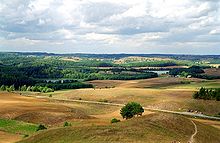













.jpg/320px-Rajgród,_Poland_-_panoramio_(23).jpg)






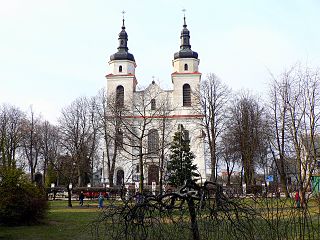

















.jpg/350px-Rynek_Kościuszki,_Białystok_(2).jpg)


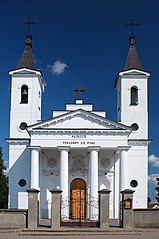











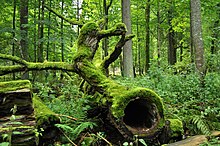












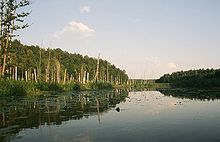
.jpg/220px-Jezioro_-_Blizno_-_panoramio_(5).jpg)

.jpg/320px-Jezioro_-_Blizno_-_panoramio_(3).jpg)
.jpg/320px-Lazdijų_sen.,_Lithuania_-_panoramio_(43).jpg)


.jpg/320px-Pomorze(lake).jpg)





_02.JPG/350px-Augustów_-_Jezioro_Białe_(by_Pudelek)_02.JPG)


.jpg/350px-Nowy_Dwór_Mazowiecki,_Terminal_-_fotopolska.eu_(329160).jpg)


